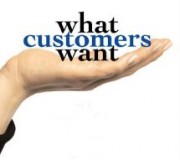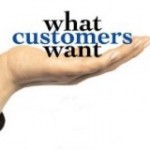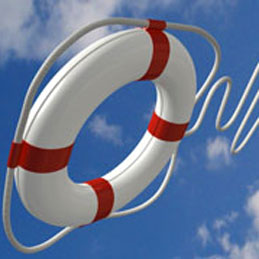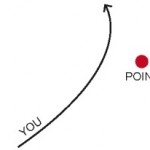 For those of you who are in the retail industry, you may have noticed a recent trend to clean up in-store environments – reduce shelf heights, remove dense ends and dump bins, widen aisles etc. – in order to increase comfort and make the shopping experience less stressful for customers.
For those of you who are in the retail industry, you may have noticed a recent trend to clean up in-store environments – reduce shelf heights, remove dense ends and dump bins, widen aisles etc. – in order to increase comfort and make the shopping experience less stressful for customers.
The big question then becomes “does clean make customers keen”? According to Walmart, arguably the largest and most successful retailer in the world, clean stores mean fewer beans (on the bottom line).
As reported in the New York Times, Walmart conducted a massive in-store experiment to improve sight-lines, rationalize the overall number of items offered, remove warehouse-like merchandising in centre aisles, and increase the width of core aisles. According to Walmart’s CEO William S. Simon, “(Customers) loved the experience. They just bought less.”
As a result, Walmart reverted back to its original strategy of offering more products, with tighter aisles, more clutter and lots of bargain bins in the hopes that customers would spend more because of a perception “there were bargains to be had”.
If you do a quick search on the internet, there are dozens of experts who subscribe to the view that a larger selection, more bargain bins, and sales signage equates to “better value”. In essence, the more you look like a market stall, the better it is to generate buzz and sales. They argue that if your merchandise is neatly presented on the walls and in well organized aisles, with no point of sale impulse offers and dense ends full of 2-for-1 specials, customers will tend to think your store is expensive (i.e. overpriced) and they will not buy from you.
And if you think about it, you can probably name a whole list of retailers who subscribe to this “clutter is good for business” philosophy and they seem to be successful. But how can we be sure that clutter makes customers keen? Have we been too quick and prematurely jumped to a conclusion that clean is a traffic and transaction turn-off?
Recent empirical evidence from neuroscience and neuromarketing sheds new light on how we think, and more importantly, how we make decisions. In fact, the decision making part of your brain responds strongly to certain stimuli only.
Did you know that your brain consumes 25% of your body’s energy? As a result, you brain wants to conserve energy so you tend to pay attention and be attracted to things that have sharp contrast, high visual appeal, strong emotional cues and a clear beginning vs. end message.
Now what does this mean for you in the context of your shopping environment?
A chaotic, cluttered store is cumbersome for your brain to navigate – you have to work hard mentally to hunt down and search for bargains. It may create some emotional appeal but it is likely perceived as having low contrast, low visual appeal and no clear beginning vs. end. According to neuromarketing studies, shopping in this environment takes time and energy and it also forces your brain to go into “thinking” mode. This is a critical point because thinking is counter-productive to deciding. Thinking takes place in one part of your brain (the neo-cortex), while deciding happens much more quickly (and automatically) in your old or “reptilian” brain.
So what does this neuromarketing research mean for the strategy and conclusions reached by Walmart?
Based on neuroscience, the strongest buying cue that you can give your customers is this – if your store (or business) has incredible bargains, people will buy (and even sift through a maze of clutter) because something is in it for them. The “what’s in it for me” (WIFM) principle is one of the strongest influences on the part of your brain that decides.
However, there is no hard evidence to suggest that clutter makes your customers keen.
Walmart and many others have come to a conclusion based on what they THINK people are doing to reach a buying decision in-store. However, neuromarketing has produced empirical evidence to support the opposite conclusion is more probable. Clutter and chaos create an environment where your customers have to think too hard, which is exhausting for the brain. They will do it if they have to, as long as the perceived bargains and value are very high.
Wouldn’t it make more sense to find another way to communicate good value and service without exhausting your customers and causing them to waste their time?
Wouldn’t you be more likely to get more sales and word of mouth referrals from your delighted customers?
In the end, Walmart may be correct about the fact people buy more in certain circumstances but they are wrong about WHY that is. The best way to create more excitement and sales is to make it easier for your customers to decide. You need to show them what’s in it for them, increase the contrast between your solution and your competitors and communicate a strong, clean visual message that compels them to say “YES”.
Is your business growth starting to plateau or stagnate?
It’s easy to sit back, take the foot off the accelerator and watch the sales roll in, especially if you’ve been satisfied with your recent performance. But keep in mind that if you slack off too much, your competitors will soon catch up and eventually put you out of business. At some point you may even find that you have stopped providing what your customers want.
Take a look around – businesses (and your competitors) are closing their doors due to the drop in consumer spending – which means MORE potential customers for businesses like YOU, that do survive. Today is the best time to take steps to revamp your marketing efforts and respond to the needs and the pain of your target market.
In these tough times, it’s going to take more than “thinking outside the box” and goodwill with existing customers to secure the survival of your business.
I want you to STOP right now and make a list of everything that you (and your competitors) do NOT do to make it easy for your prospects to buy from you. If you want to succeed over the long term, you will take a good hard look at both of these lists and find a way to do whatever it takes, for as long as it takes, to win your customers and keep them.
Granted, this is not an easy task. Most businesses will continue to do what they have always done – guess or assume what they think their customers need. However, no matter how challenging it is to ask the hard questions and re-engineer your strategy, I guarantee it will be a whole lot less painful and stressful than going under.
I had a married couple come to me once for advice and coaching – both the business they were in and their relationship were at the breaking point. The husband turned and said to me “I don’t understand it. I do everything humanly possible for my wife and she doesn’t appreciate me and I don’t think I can possibly do anything more to satisfy my customers – they are never happy and always want more. What can I possibly do?”
My answer to this age old dilemma applies to him, his marriage, and to you in your business right now. “Sounds like you are doing a lot. Too bad it’s everything BUT the very thing that your partner and customers need most.”
While this may sound harsh, I think you will agree that it is absolutely true. It does you no good to work harder doing everything…instead of focusing on the 1 thing that you customers actually need. Wouldn’t it be easier for you to work smarter, not harder, if you knew with absolute certainty what that 1 thing is?
How can you take the lesson from my client and apply it to your own business right now?
How could you go about figuring out what that 1 thing is?
I want you to do something really radical today and start asking both your prospects and existing customers what they need. You need to find out:
• What is the biggest challenge your prospects are facing in their business?
• When your customer thinks of the product or service you provide, what is THE most painful or difficult issue associated with acquiring it?
• What is the most important criteria to your purchaser when evaluating a company like you?
• What are some things that he/she thinks about or considers from a financial perspective when selecting that product/service or a vendor?
• What is the key strategic driver for you customer’s decision?
It doesn’t really matter what you have done up to this point or how hard you are working. There is no prize for volume or quantity. What counts is quality and relevance. You need to do determine what your customers want…and give it to them.
If you had to pick 1 thing – 1 strategy or change that you could implement in your business that would allow you thrive despite tough economic times, what would it be?
Let’s make a list of the top 5 things that I hear most business owners (like you) say when I ask them the same question…
- Spend money on marketing – attract new customers
- Have a sale
- Ask for referrals or help
- Tighten your belt – cut costs
- Do more networking
Now what do all of these have in common?
They all involve you doing more of the same thing that you have always done. None of these involve a radical shift in the way that you do business, do they? None of these involve you taking a step back and re-examining what you do and whether it’s actually working. And none of these involve you changing the way that you communicate what you do to your customers.
And that is precisely why none of them will work to recession proof your business.
So why is that important?
Because consumer sentiment and spending has changed dramatically in the past few years and those changes are being felt across every industry and by both big and small businesses. Everything you thought you knew about your customer and why she was buying from you has probably changed. And if you don’t take the time now to re-discover your prospect’s main source of pain – the reason why she needs your product or service – you risk losing more sales and more ground to your competition.
Now some of you are probably sitting there thinking “but MY industry is different. You may think that you’ve been hit especially hard and that everyone in your niche has lost sales. But that’s not the case for 99% of you. Even some of the most competitive and vulnerable industries have companies who have continued to perform well and who have even stole market share.
Just for a moment, I want you to cast your mind back to the first few months after the GFC. A lot of people lost their life savings during the stock market crash and many lost their jobs immediately after that. It was a horrific few months and few industries felt the wrath of the crash more so than the automotive sector. If you remember, new car sales dropped by almost 20% in a short period of time and stayed that way for almost a year. That’s a huge drop in an industry that is vital to the health of the national economy.
Now sales of new cars were down 20% for the industry. Despite the massive drop in sales, 1 manufacturer actually managed to gain market share and outperform all other companies in sales growth. Do you remember who that was and why?
Only 1 company stopped and took a good hard look at the pain their customers were in at the time. They didn’t do what all the others did – which was spend more money on newspaper ads, lay off salespeople and slash new car prices.
Only 1 company examined the change in the market, correctly diagnosed the pain of their prospects and came up with a solution. “If you lose your job and can’t make the payments, no problem – we will take it back free of charge”.
Do you remember who that was? That’s right Hyundai.
With one simple change to their focus and strategy they stole market share from every other manufacturer because they correctly identified the shift in their customer’s pain. They didn’t keep going on with the same old strategy and approach that clearly wasn’t working. Yes, there had been a major downturn and the whole industry was hit hard, but there were still lots of customers who wanted to buy a new car but were afraid to do so because they might lose their jobs.
So how can you apply this to your market right now? First and foremost, your customers are not thinking about you, your brand and your features and benefits – they are thinking about their own survival and whether or not you can cure their pain. If you are able to correctly diagnose the pain, you will trigger the part of their brain that makes decisions and you will stand apart from your competition. That’s the power of Sales Seduction.
Think about one of your customers right now and her pain? What do you need to do in order to get more clarity around that? What questions do you need to ask her about how it is affecting her financially, personally and strategically? To the extent you can diagnose her pain, get her to acknowledge it and put forward the solution that cures it, she will listen to anything that you have to say.
Take a look around you… businesses are closing their doors everyday – which means more potential customers for the businesses like you that DO survive. And in times like these, it’s going to take more than just doing more of what you have always done to recession proof your business. Uncertain times call for deliberate decisions and proven practices. In order to recession proof your business you need to shift your thinking around the way you do business and start providing THE solution to the #1 pain or challenge that your customers have. And if you need some diagnoistic questions and a step-by-step framework to help you do this…I highly recommend that you check out Chapter 8 of Sales Seduction.
It has often been said that “profit is pointless and cash flow is King”. But do you know why?
It is possible for a business to show a profit for a period of time, yet have negative cash flow. In fact, businesses that have profit (on paper) go under every single day. Negative cash flow, if sustained for an extended period of time, will eventually cause the company to run out of money and cease operations. Therefore, knowing the cash flow position is critical to staying afloat and knowing how to unlock more cash flow is imperative to effectively coach a business owner or senior executive.
Are You Chasing The Wrong Target?
You can have the most brilliant product or service but if the business runs out of cash, it won’t matter. Most businesses make the fatal mistake of thinking that they simply need more customers. If only they had more customers, they would have more sales and more profit…and they would be more successful.
But is this true?
Can businesses simply advertise their way into more sales and better results? No. In fact, advertising and discounting often have a negative impact on the bottom line and cash flow.Simply put – the initial instinct most coaches and business owners have is to focus on increasing sales. Employing this strategy in a business coaching context – chasing customers and sales – is often the worst thing you can do for the business.
The common assumption is that if you are running a business (or involved in business coaching) where the price you charge for your products is greater than what they cost, everything will be okay: you will be profitable and successful. Profit is good – don’t get me wrong – but it is simply not enough on its own. To be sustainable, the business must also have a healthy cash flow.
If you are like most coaches and business owners, you never dreamed that the ability to understand how money flows in and out would be incredibly important. You thought: “That’s for the accountant or finance department to worry about. Sure, they may show me a few reports from time to time, but I don’t see the need to really understand what the numbers mean. If there was a problem, they would tell me, wouldn’t they?”
You probably didn’t realise that all those numbers – the financial DNA of the business – can tell you a lot more than you thought. They can tell you why the business is not growing or is struggling to meet targets. They can reveal why there is less money in the bank account [again] than there was last month.
The financial numbers ARE the story of the business. Numbers don’t lie. They are one of the few objective indicators of how a business is performing and where the problems are. Ironically, financials are the most overlooked area of business coaching with the majority of practitioners choosing to specialize in leadership, sales or marketing disciplines. Unfortunately, without a solid understanding of financials, it is impossible to coach effectively and produce predictable results.
Regardless of any justifications you (or your business coaching clients) use to explain why the business is not performing – the economy, the shortage of ‘good’ staff, competition, supply chain issues etc. – the numbers tell the truth and can lead you to the solution. You just need to learn HOW to use them to your advantage.
You need a bit of Financial Foreplay®.
Are You Avoiding The Numbers?
When is the last time you took two hours out of your week to analyze the financial statements of a client or your own business? Can you honestly say that you know exactly where you (or they) are at and WHY? Do you sometimes wonder what the numbers are trying to tell you? Are you guilty of wasting money chasing new leads and sales instead of fixing the business and making it more profitable?
Most business coaches and business owners make the mistake of assuming they can improve the business by examining the Profit and Loss and Balance Sheet on a monthly basis. Unfortunately, these statements only tell part of the story. In fact, you cannot measure the cash flow position of a business by looking at the bank balance or examining the financial statements at a specific point in time.
This is because most businesses use what’s called ‘accrual’ accounting. Rather than recording ‘money spent’, they record spending as ‘money spent plus money committed to be spent’. So if stock has been purchased on account, accrual accounting includes the value of that purchase from the point it is made – not from the point when the account is paid. Accrual accounting takes into account the amount of money that has been spent plus committed to be spent in the future. The same thing happens in reverse with earnings – it includes money received plus money expected to be received. When a sale is invoiced with 30 days to pay, the value of that invoice is included in accrual earnings even though the money won’t be received for at least another 30 days.
Therefore, when accountants talk of ‘profit’, then, they usually mean ‘accrued profit’ as opposed to what we would call ‘real or cash profit’. Accrued profit is the expected real profit after ‘spending already committed to’, and ‘earnings expected to be received’, are
taken into account along with real (cash) spending and real (cash) earnings. As a result, the profit showing on an Income (or Profit and Loss) statement is a more complicated and less useful representation of the current financial situation of a business. Net profit cannot be relied upon in isolation to gauge the financial health of a company.
Stated another way, cash flow must be tracked over a period of time and can be measured by the following calculation:
Net profit (year to date)
+/- changes in inventory
+/- changes in accounts receivable
+/- changes in accounts payable and GST and
+/- changes in fixed assets
= Cash Flow
Changes in these 4 items on the Balance Sheet have a significant impact on the cash flow and viability of a business. That is why getting inventory levels right, optimizing receivables and payables and investing only in assets that generate a return, is critical when coaching a business of any size. In fact, a coach can often have more tangible impact and influence on a business by focusing on these 4 areas than on directing effort towards gaining new customers and increasing sales. And oftentimes, it costs the business very little to implement highly effective strategies in these 4 areas.
In practice, it is vital to have an eye on both real profit (cash flow position) as well as accrued profit. It is a common error to focus solely on accrued profit – an error which has the potential to send a business to the wall prematurely.
Are You Sure It’s Profitable?
Profitable growth should be the goal of any business. However, you cannot achieve profitable growth without first establishing that the business is in fact profitable. Attracting more leads or closing more sales may not be enough – the costs and efficiencies in a business change every day and this means that we must constantly monitor and measure results and take appropriate action. Focusing solely on customers and sales is a bit like spending 100% of your time practicing your tennis serve while neglecting to watch the scoreboard, analyze the strategy of competitors and practice your returns.
Break-even is one of the most simple and powerful calculations that you can use yourself and with your clients each month to measure and enhance profitability. A company is said to “break-even” for a period (usually a month) when its sales revenue catches up to its costs. Specifically, accountants talk about break-even as the point where ‘fixed costs’ (rent, salaries, etc.) are matched by ‘gross profit margin’ (sales revenue minus COGS).
Therefore, it follows that break-even with profit is the point in the month where the business covers all of the fixed and variable costs and starts making the desired profit target. Remember, if you and your clients are in business and not running a charity, the goal is profitable growth. In order to achieve profit, you MUST in fact plan to achieve it.
Calculating break-even (and break-even with profit) each month and knowing specifically which day of the month the business breaks-even, allows management to make informed, strategic decisions about how to achieve growth that is profitable for the bottom line and enhances the cash flow position.
Are You Ready To Get Results?
Knowing where the financial pain is when you are coaching a business allows you to focus your time and resources where they will make the greatest impact on the bottom line. And if you are truly serious about being a successful business coach, and it is not just a hobby or a way to pass the time, you will find a way to fit a bit of Financial Foreplay® into your day so that you can help others to whip their businesses into shape and start taking home more cash! It’s the quickest and most effective way to get your clients working ON not just IN their businesses.
 I have read quite a few articles and blogs lately from business coaches who advocate that you should spend money to get “likes” on your business page in Facebook and followers on other forms of social media. With all due respect, this is by far the most foolish and financially irresponsible strategy I’ve ever heard of. If your coach or advisor is telling you to do this, you need to need to understand that there are at least 3 good reasons why you should NEVER do this:
I have read quite a few articles and blogs lately from business coaches who advocate that you should spend money to get “likes” on your business page in Facebook and followers on other forms of social media. With all due respect, this is by far the most foolish and financially irresponsible strategy I’ve ever heard of. If your coach or advisor is telling you to do this, you need to need to understand that there are at least 3 good reasons why you should NEVER do this:
- While it is nice to have people like your page, you need to think about what the end game is. Likes don’t put money in your bank account and food on the table for your family. What you really need in your business is a good steady stream of qualified leads who are ready to pay you for your solution. Likes are not leads. They may like your page one day and never return or pay very little attention to the posts on your Facebook page.
- Facebook has recently changed the way their ads work (yet again) for posts on your business page. Even if you have thousands of followers, you must now pay to talk to them. In the old days, you could send messages and your posts were given priority in the newsfeed of your followers. Not anymore. Now, you must pay to promote each post you make or virtually no one will ever see it (no matter how many likes you have). With Facebook, you must pay to acquire the likes AND also pay to speak with them.
- When you send traffic to your own website and they give you permission to contact them, you are building the most important asset in your business: your list. Your list allows you to build a relationship with prospects and customers and it also buys you time to present your claim, solve their pain and prove that you can do it. Once you own your list, speaking to them is virtually free. No matter what, you have this list and it is always the most cost effective way of building your business. If someone else, like Facebook or any other social media site, owns your list, then they control how, what and when you can communicate – and how much you must pay to do it. If Facebook went off line or out of business, what would happen to the so-called list of followers you paid dearly to acquire?
As a small business can you really afford to buy likes on social media or should you spend your time and limited marketing budget on generating qualified leads who will pay you for your solution?
The most successful brands in the world don’t waste their money on likes. Instead they focus their time and money on influencing and persuading you to buy their solution. They know exactly how to push the “buy button” in your brain and they do it successfully over and over again.
They have ALL mastered 1 simple technique and they secretly hope that YOU will never discover what it is. As a small business owner, they currently have an unfair advantage over you but that is about to change… In my free online event on December 6th, 2012, I will reveal why this 1 technique is so damn effective and how you can use it to instantly influence and persuade your customers.
















